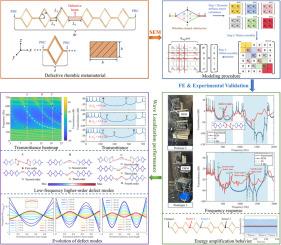多波段低频振动局部化的高阶缺陷超材料
IF 9.4
1区 工程技术
Q1 ENGINEERING, MECHANICAL
International Journal of Mechanical Sciences
Pub Date : 2025-09-18
DOI:10.1016/j.ijmecsci.2025.110859
引用次数: 0
摘要
由于缺陷态能够定位振动能量,缺陷超材料在滤波、传感、波导和能量收集方面的应用具有巨大的潜力。然而,布拉格散射的限制通常将这些状态限制在高频范围内,并且它们在单个带隙内是稀疏的。传统的添加多个缺陷的策略拓宽了光谱,但存在缺陷间色散,削弱了能量集中。本文提出了一种新的缺陷菱形超材料(DRM),以实现单点缺陷的多频段低频缺陷状态。其新颖性在于两个机制:(1)菱形结构的低有效刚度显著降低了带隙频率,而不增加晶格尺寸;(2) DRM支持高阶缺陷状态,使多个局部模式在单个带隙内共存,同时保持强局部化。首先利用有限元模拟分析了DRM的能带结构,论证了低频高阶缺陷模的概念。随后,采用谱元法(SEM)评价透光特性,并进行参数化研究,探讨几何参数对能量局域化行为的影响。最后,实验验证了理论和数值预测,为亚千赫兹范围内高阶缺陷模的存在提供了第一个实验证据。总的来说,这项工作提出了一种利用紧凑的单点缺陷超材料进行宽带低频能量定位的有前途的策略,为小型化能量采集器的更高功率密度和传感应用的提高分辨率铺平了道路。本文章由计算机程序翻译,如有差异,请以英文原文为准。

Higher-order defective metamaterial for multi-band low-frequency vibration localization
Defective metamaterials offer significant potential for applications in filtering, sensing, waveguiding, and energy harvesting, owing to defect states capable of localizing vibrational energy. However, constraints from Bragg scattering typically restrict these states to high-frequency ranges, and they are sparse within a single bandgap. Conventional strategies that add multiple defects broaden the spectrum but suffer from inter-defect dispersion that weakens energy concentration. In this study, a novel defective rhombic metamaterial (DRM) is proposed to achieve multi-band low-frequency defect states from a single-point defect. The novelty rests on two mechanisms: (1) the rhombic geometry’s low effective stiffness significantly lowers the bandgap frequency without enlarging lattice size; and (2) the DRM supports higher-order defect states, enabling multiple localized modes to coexist within a single bandgap while maintaining strong localization. The band structures of the DRM are first analysed using finite element (FE) simulations, demonstrating the concept of low-frequency higher-order defect modes. Subsequently, the spectral element method (SEM) is employed to evaluate the transmittance characteristics, followed by parametric studies to explore the influence of geometric parameters on energy-localization behavior. Finally, the theoretical and numerical predictions are validated experimentally, providing the first experimental evidence of higher-order defect modes in the sub-kilohertz range. Overall, this work presents a promising strategy for broadband low-frequency energy localization using compact single-point-defect metamaterials, paving the way for higher power density in miniaturized energy harvesters and enhanced resolution in sensing applications.
求助全文
通过发布文献求助,成功后即可免费获取论文全文。
去求助
来源期刊

International Journal of Mechanical Sciences
工程技术-工程:机械
CiteScore
12.80
自引率
17.80%
发文量
769
审稿时长
19 days
期刊介绍:
The International Journal of Mechanical Sciences (IJMS) serves as a global platform for the publication and dissemination of original research that contributes to a deeper scientific understanding of the fundamental disciplines within mechanical, civil, and material engineering.
The primary focus of IJMS is to showcase innovative and ground-breaking work that utilizes analytical and computational modeling techniques, such as Finite Element Method (FEM), Boundary Element Method (BEM), and mesh-free methods, among others. These modeling methods are applied to diverse fields including rigid-body mechanics (e.g., dynamics, vibration, stability), structural mechanics, metal forming, advanced materials (e.g., metals, composites, cellular, smart) behavior and applications, impact mechanics, strain localization, and other nonlinear effects (e.g., large deflections, plasticity, fracture).
Additionally, IJMS covers the realms of fluid mechanics (both external and internal flows), tribology, thermodynamics, and materials processing. These subjects collectively form the core of the journal's content.
In summary, IJMS provides a prestigious platform for researchers to present their original contributions, shedding light on analytical and computational modeling methods in various areas of mechanical engineering, as well as exploring the behavior and application of advanced materials, fluid mechanics, thermodynamics, and materials processing.
 求助内容:
求助内容: 应助结果提醒方式:
应助结果提醒方式:


